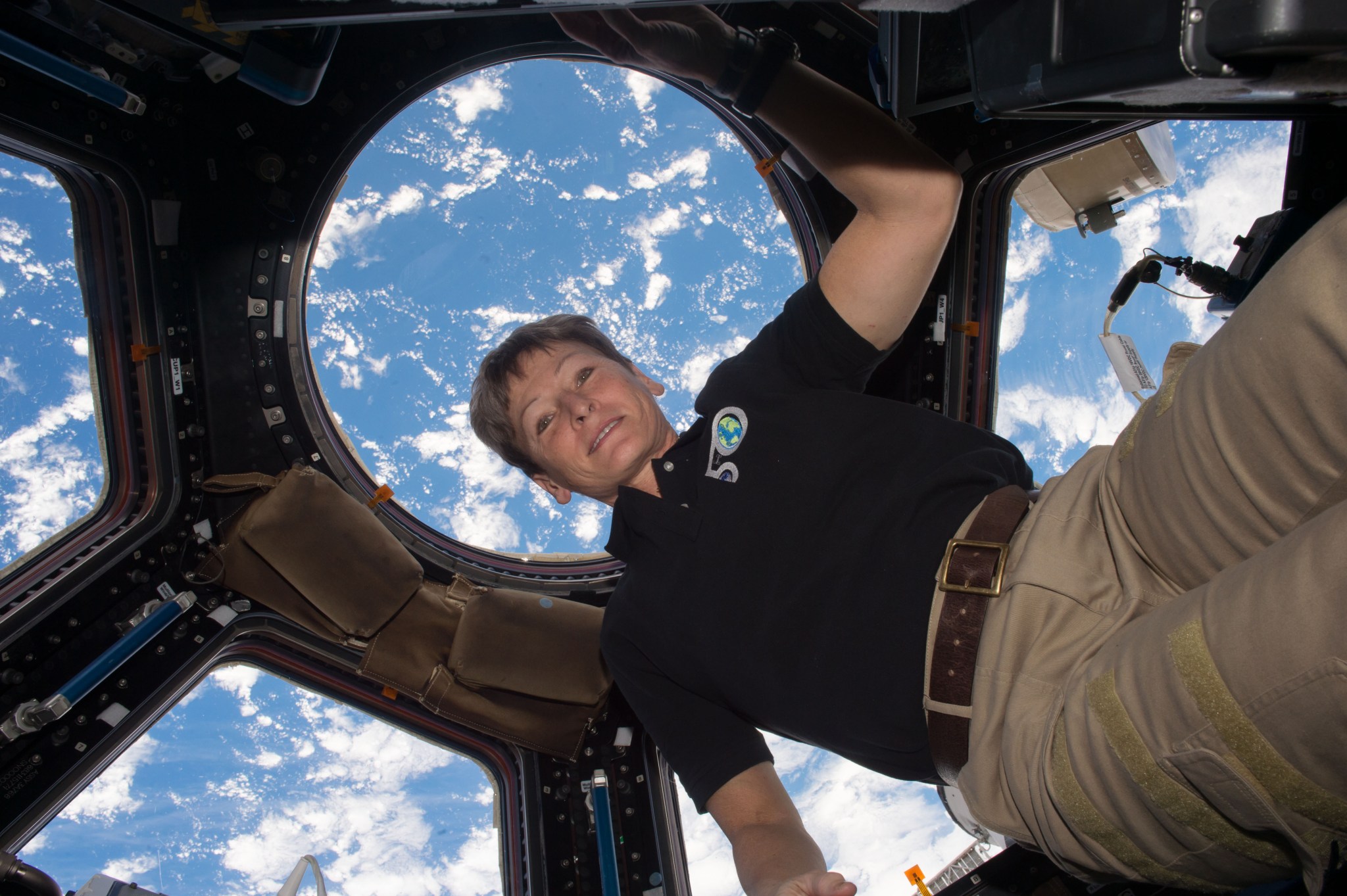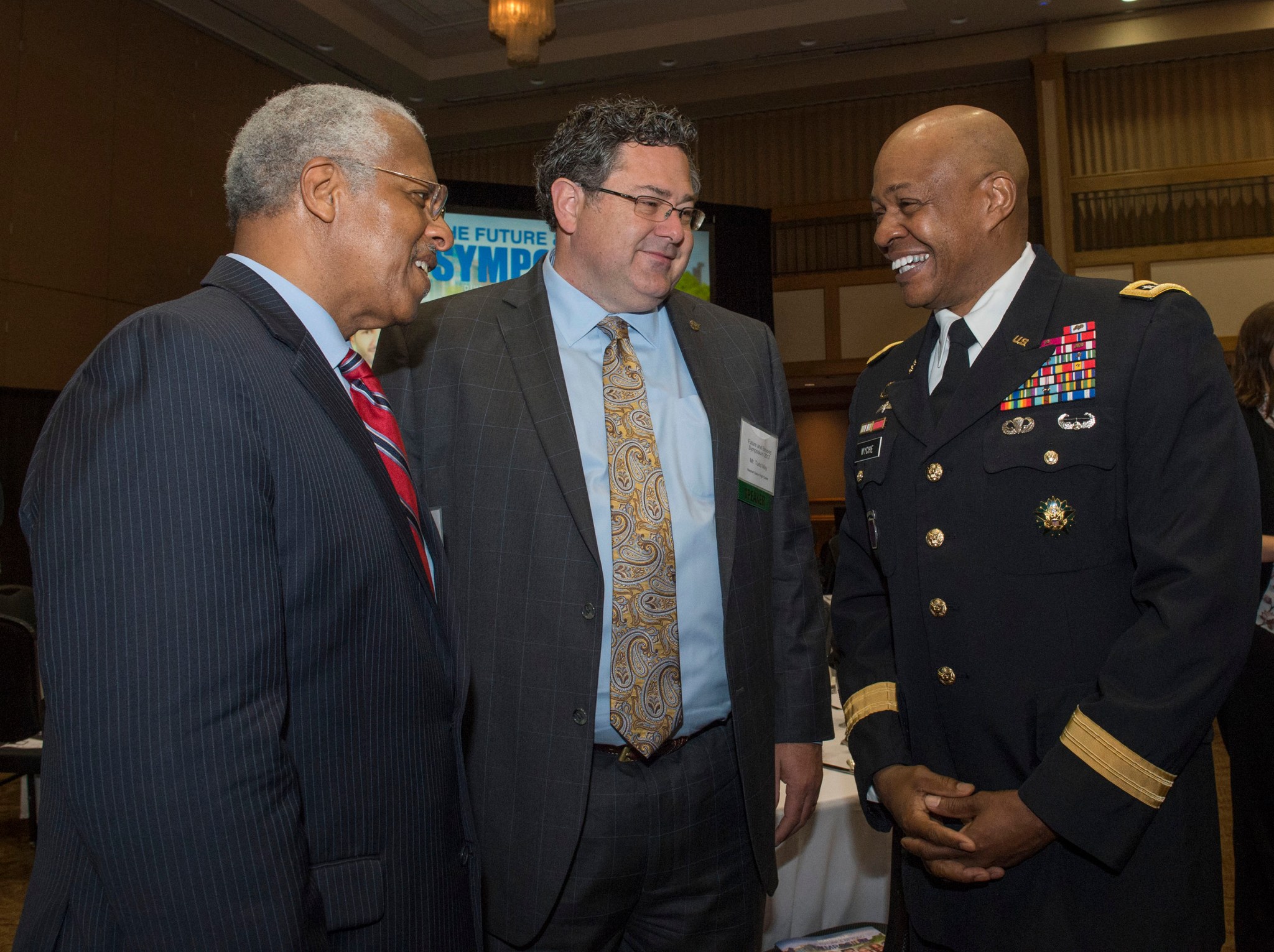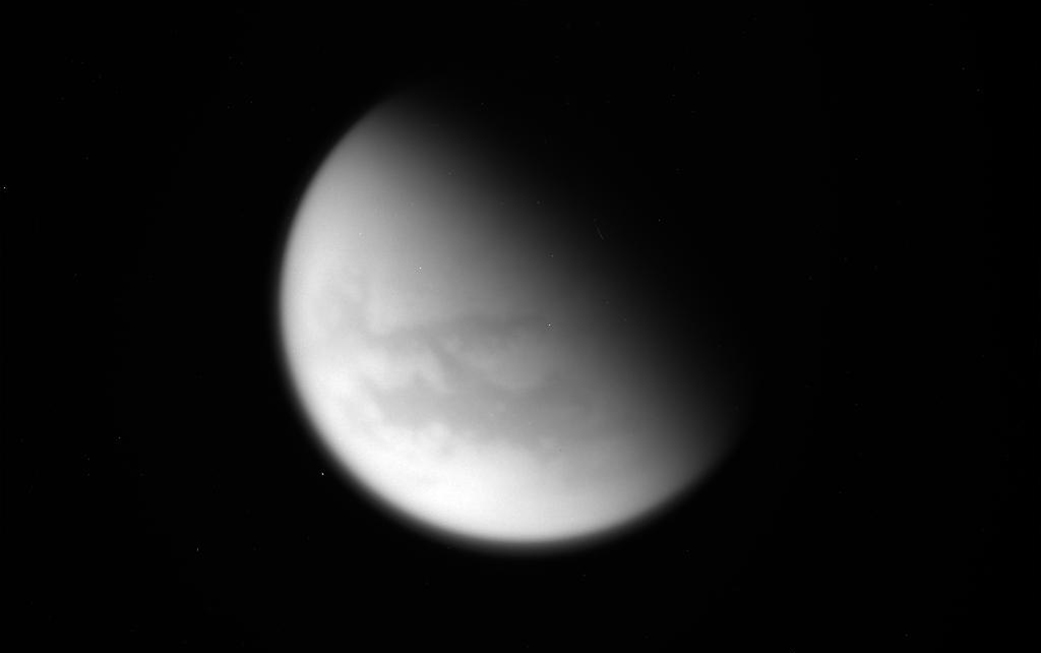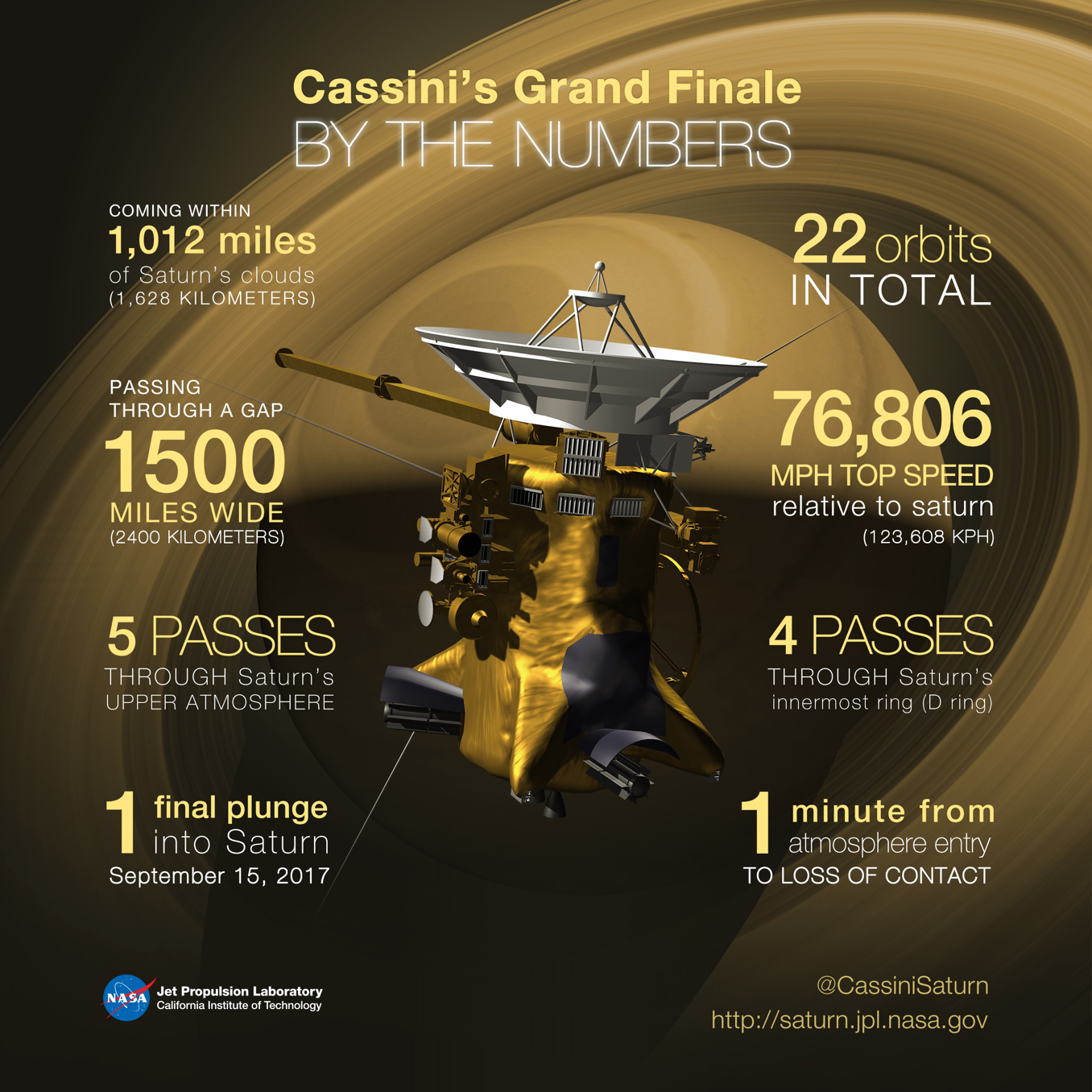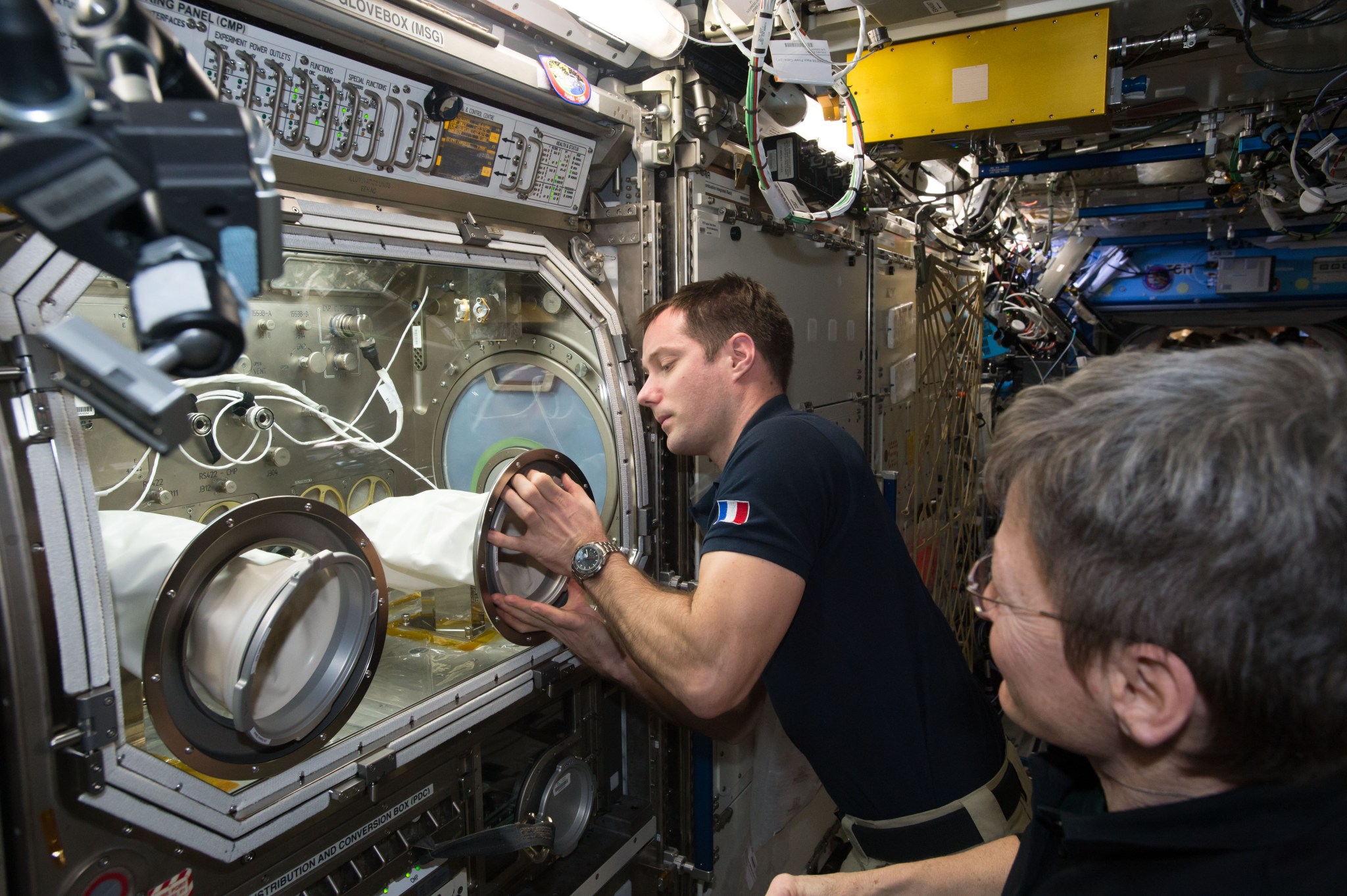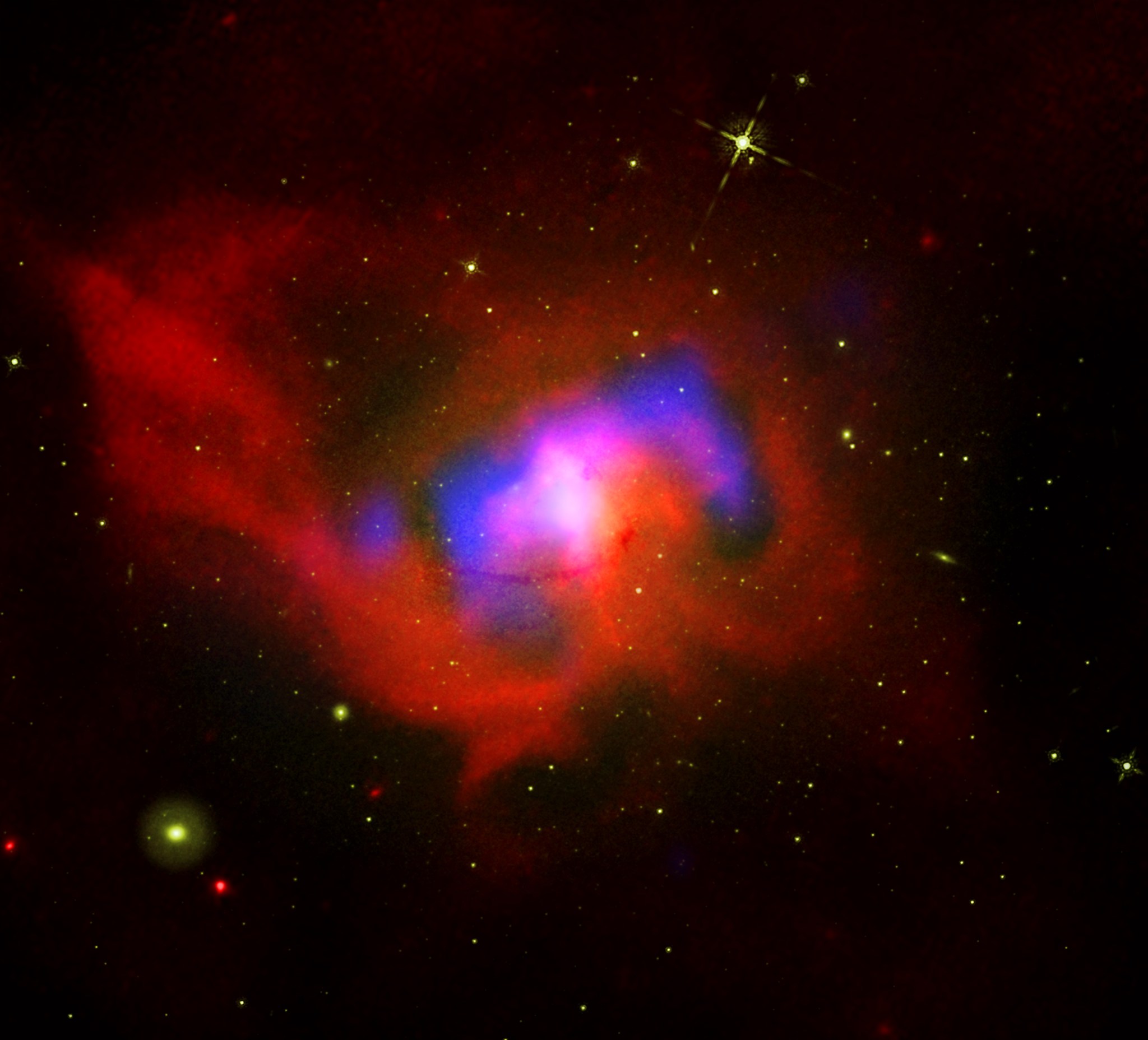In This Week’s Star
- New Crew Arrives at International Space Station
- NASA Astronaut Peggy Whitson Breaks U.S. Space Record
- Major SLS Integrated Structural Tests Continue at Marshall
- Marshall, Redstone, Huntsville-area Businesses Unite for Diversity Symposium
- Cassini Completes Final — and Fateful — Titan Flyby
- Additional Astronaut on the Space Station Means Dozens of New Marshall Team Members
- Plants Text Message Farmers with a Marshall Spinoff
- The Arrhythmic Beating of a Black Hole Heart
- This Week in NASA History: Hubble Space Telescope Deployed — April 25, 1990
- Obituaries
New Crew Arrives at International Space Station
After a six-hour flight, NASA astronaut Jack Fischer and cosmonaut Fyodor Yurchikhin arrived at the International Space Station at 8:18 a.m. April 20 where they will continue important scientific research.
The two launched aboard a Soyuz MS-04 spacecraft from the Baikonur Cosmodrome in Kazakhstan at 2:13 a.m. and orbited Earth four times before docking at the space station.
The arrival of Fischer and Yurchikhin increased the station’s crew complement to five. The two join NASA astronaut Peggy Whitson, Russian cosmonaut Oleg Novitskiy and European Space Agency astronaut Thomas Pesquet. The Expedition 51 crew members will spend more than four months conducting approximately 250 science investigations in fields such as biology, Earth science, human research, physical sciences and technology development.
Novitskiy and Pesquet will remain aboard the station until early June. Fischer and Yurchikhin are scheduled to remain aboard the station until September, along with Whitson, whose stay aboard the station was extended into Expedition 52 by an agreement recently signed between NASA and Roscosmos.
The expanded Expedition 51 crew soon will conduct new science investigations which arrived on Orbital ATK’s seventh NASA-contracted commercial resupply mission April 22. Investigations included an antibody investigation that could increase the effectiveness of chemotherapy drugs for cancer treatment and an advanced plant habitat for studying plant physiology and growth of fresh food in space. Another new investigation bound for the U.S. National Laboratory will look at using magnetized cells and tools to make it easier to handle cells and cultures, and improve the reproducibility of experiments.
Cygnus also carried 38 CubeSats, including many built by university students from around the world, as part of the QB50 program. The CubeSats are scheduled to deploy from either the spacecraft or space station in the coming months.
Fischer and Whitson are scheduled to take part in the fifth spacewalk of the year on May 12. The pair’s main task will be to replace an avionics box on the starboard truss. The box houses electrical, and command and data routing equipment for science experiments and replacement hardware stored outside the station.
The crew members also are scheduled to receive one Russian Progress resupply mission delivering several tons of food, fuel, supplies and research.
For more than 16 years, humans have lived and worked continuously aboard the International Space Station, advancing scientific knowledge and demonstrating new technologies, making research breakthroughs not possible on Earth that will enable long-duration human and robotic exploration into deep space. A global endeavor, more than 200 people from 18 countries have visited the unique microgravity laboratory that has hosted more than 1,900 research investigations from researchers in more than 95 countries. These invesigations are managed and guided at the Payload Operations Integration Center – mission control for science on the station located at NASA’s Marshall Space Flight Center.
For more information, visit the International Space Station Research and Technology web page.
NASA Astronaut Peggy Whitson Breaks U.S. Space Record
On April 24, NASA astronaut Peggy Whitson set a new American record for cumulative days spent in space at 535 and counting. President Donald Trump called the International Space Station to personally congratulate Whitson for her accomplishment, as did the previous record-holder, NASA astronaut Jeff Williams. During her three missions to the space station, Whitson has conducted multiple science investigations with help from team members working in Marshall’s Payload Operations Integration Center, NASA’s control room for station science. Whitson is scheduled to remain in space until September, potentially setting a new mark at more than 660 total days in space. No stranger to breaking records, Whitson was the first woman to command the space station, and is the only woman to command it twice. In addition, she holds records for most spacewalks by a female with eight, and most spacewalk hours by a female with more than 53. Learn more by following @AstroPeggy on Twitter. (NASA)
Major SLS Integrated Structural Tests Continue at Marshall
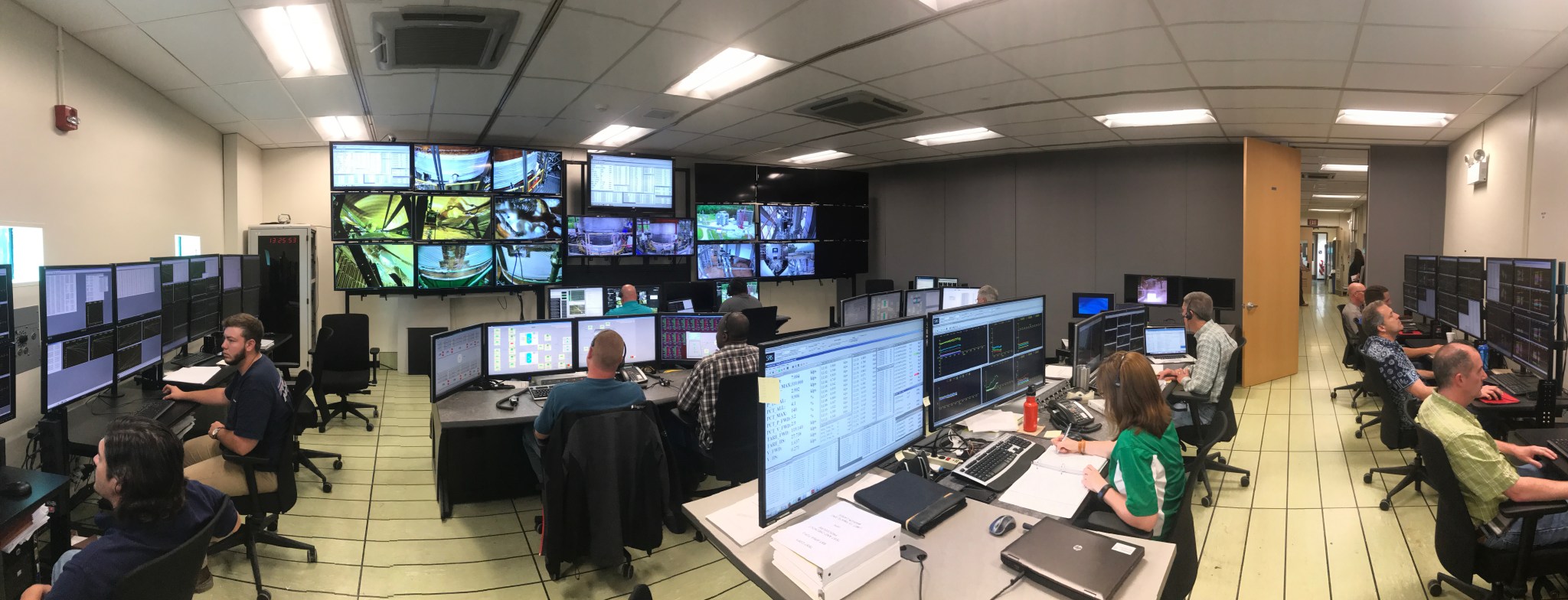
Inside this control room in NASA Marshall Space Flight Center’s East Test Area, engineers are conducting a rigorous set of integrated structural tests for the Space Launch System. The test series is on qualification articles that make up the upper portion of the SLS rocket — the launch vehicle stage adapter, interim cryogenic propulsion stage, Orion stage adapter and the frangible joint assembly that is part of the separation system on the rocket. For testing, the hardware is equipped with simulators and stacked as it will be for launch. Rather than liquid oxygen and liquid hydrogen used for launch, liquid nitrogen is used for the test to pressurize the stage’s fuel tanks. Liquid nitrogen is the safest cryogenic for testing, with no smoke and fire. Large hydraulic systems inside the test stand push, pull and twist the integrated stack of hardware to simulate the extreme loads, or pressures, it will encounter during flight. Information gleaned will ensure the hardware is structurally sound for flight. (NASA/MSFC/Brian C. Massey)
Marshall, Redstone, Huntsville-area Businesses Unite for Diversity Symposium
By Bekah Schmidt and Rick Smith
On April 20, NASA’s Marshall Space Flight Center helped launch “The Future and Beyond,” a business symposium championing the value and impact of diversity and inclusion in the Huntsville-area workplace.
To complete its missions on behalf of NASA, Marshall must develop and nurture successful teams comprised of top talent. Employee development at Marshall goes beyond periodic retraining. A successful Marshall team is made up of a diverse workforce where everyone brings to bear their different skills, background and perspectives, not only strengthening the team but fostering creativity and innovation.
With Huntsville and the surrounding Madison County poised to become the largest city in Alabama in the next 10 years, city planners predict, Marshall regularly works with industry and community partners to address the topic of diversity and inclusion in the Tennessee Valley. As a city, Huntsville can recruit top talent, symposium organizers said, but to be successful the city also must retain talent. That requires cultivating and nurturing an inclusive community which offers everyone not just a seat at the table, but a voice as well.
The symposium was the culmination of two years of planning to host “a community conversation” about workplace diversity and inclusion, organizers said. Marshall cosponsored the event with the City of Huntsville; the non-profit Leadership Huntsville/Madison County; Alabama A&M University in Normal; and the University of Alabama in Huntsville.
Larry Mack, deputy director of Marshall’s Office of Human Capital, has been part of the planning process since early 2016. “The entire goal of the symposium is to initiate an on-going dialogue focused on openness, diversity and responsible norms in our respective communities,” he said. “We were strategic and deliberate in approaching public and private partners and inviting them to take part in this symposium.”
The ongoing conversation
Business leaders, city officials and employees from various companies who attended the free symposium heard from local leaders and national diversity and inclusion experts including Roosevelt Johnson, NASA deputy associate administrator for education; Marshall Center Director Todd May; Huntsville Mayor Tommy Battle; and Redstone Arsenal Senior Commander Lt. Gen. Larry Wyche, deputy commanding general for the U.S. Army Materiel Command.
“I want everyone here to take a good look in the mirror,” Wyche told participants. “Now ask yourself the question: Would you want to work for yourself? Speaking with your boss about inclusion isn’t a onetime event — it’s an ongoing conversation.”
Marshall Deputy Director Jody Singer said it all boils down to caring for one another. “Listen, value one another’s opinion and seek understanding. This is the basis for everything,” she said. “When people feel safe in their environment and are able to be who they are, this creates an inclusive environment that allows everyone to contribute.”
That inclusive environment will result in higher productivity, more creativity and more innovation, Singer continued. “Inclusion is the gift that keeps on giving,” she said.
Making people count
Being a diverse organization isn’t enough, said corporate trainer Steve Robbins during the morning’s keynote address. “It’s not enough just to get diversity to the table,” he said. “To have inclusion in an organization you need to change the perspective of people already at the table. Having an open mind is the key to creating a successful inclusive environment.”
Johnson, who visited Huntsville from NASA Headquarters, delivered the afternoon keynote, in which he observed that whereas diversity may simply be “a matter of counting people,” real inclusion means making people count.
“Giving everyone a voice and safe place to foster their talents is how we not only create a more productive workplace, but how we retain our workforce,” Johnson said.
Schmidt, marketing and public relations director for Leadership Huntsville/Madison County, penned a previous version of this story for The Redstone Rocket. Smith, an ASRC Federal/Analytical Services employee, supports Marshall’s Office of Strategic Analysis & Communications.
Cassini Completes Final — and Fateful — Titan Flyby
NASA’s Cassini spacecraft has had its last close brush with Saturn’s hazy moon Titan and is now beginning its final set of 22 orbits around the ringed planet.
The spacecraft made its 127th and final close approach to Titan at 1:08 a.m. on April 22, passing at an altitude of about 608 miles above the moon’s surface.
Cassini transmitted its images and other data to Earth following the encounter. Scientists with Cassini’s radar investigation will be looking this week at their final set of new radar images of the hydrocarbon seas and lakes that spread across Titan’s north polar region. The planned imaging coverage includes a region previously seen by Cassini’s imaging cameras, but not by radar. The radar team also plans to use the new data to probe the depths and compositions of some of Titan’s small lakes for the first, and last, time, and look for further evidence of the evolving feature researchers have dubbed the “magic island.”
“Cassini’s up-close exploration of Titan is now behind us, but the rich volume of data the spacecraft has collected will fuel scientific study for decades to come,” said Linda Spilker, the mission’s project scientist at NASA’s Jet Propulsion Laboratory.
Gateway to the Grand Finale
The flyby also put Cassini on course for its dramatic last act, known as the Grand Finale. As the spacecraft passed over Titan, the moon’s gravity bent its path, reshaping the robotic probe’s orbit slightly so that instead of passing just outside Saturn’s main rings, Cassini will begin a series of 22 dives between the rings and the planet on April 26. The mission will conclude with a science-rich plunge into Saturn’s atmosphere on Sept. 15.
“With this flyby we’re committed to the Grand Finale,” said Earl Maize, Cassini project manager at JPL. “The spacecraft is now on a ballistic path, so that even if we were to forgo future small course adjustments using thrusters, we would still enter Saturn’s atmosphere on Sept. 15 no matter what.”
Cassini received a large increase in velocity of approximately 1,925 mph with respect to Saturn from the close encounter with Titan.
After buzzing Titan, Cassini coasted onward, reaching the farthest point in its orbital path around Saturn at 10:46 p.m. on April 22. This point, called apoapse, is where each new Cassini lap around Saturn begins. Technically, Cassini began its Grand Finale orbits at this time, but since the excitement of the finale begins in earnest on April 26 with the first ultra-close dive past Saturn, the mission is celebrating the latter milestone as the formal beginning of the finale.
The spacecraft’s first finale dive will take place on at 4 a.m. April 26. The spacecraft will be out of contact during the dive and for about a day afterward while it makes science observations from close to the planet. The earliest time Cassini is scheduled to make radio contact with Earth is 2:05 a.m. on April 27. Images and other data are expected to begin flowing in shortly after communication is established.
Additional Astronaut on the Space Station Means Dozens of New Marshall Team Members
By Bill Hubscher
NASA’s recent announcement of an additional crew member to the International Space Station, which will effectively double the amount of science data acquired from the orbiting laboratory, means a lot of changes. Most of them are on the ground at the Payload Operations Integration Center at NASA’s Marshall Space Flight Center.
The POIC, mission control for science on the station, is home to dozens of expert flight controllers who are on console around the clock, 365 days a year, supporting crew by managing investigations. These flight controllers facilitate communication between the scientists and the experiments in space and make sure those investigations have the resources needed — power, cooling and a lot of astronaut activity.

When the idea to increase personnel on the space station was first discussed more than three years ago, the Marshall team knew it would need more trained and certified people to continue the flow of science data from space.
“Our team has done an outstanding job preparing for the fourth crew member,” said Bobby Watkins, director of Marshall’s Human Exploration and Development Operations Office, which oversees the POIC. “They nearly doubled the workforce and streamlined the workflow, operations and communications processes to increase efficiency while still working their day job. The result is a credit to the passion, talent and dedication of our team.”
The new procedures were implemented April 24, and hopefully the scientists around the world with experiments in orbit didn’t even notice the seamless transition.
Katie Presson and Tim Horvath, payload operations managers at Marshall, led the teams that analyzed how the POIC functioned, searching for potential improvements.
“Part of what we do is manage the resources on the space station for the investigations there,” Presson said. “We decided we could also better manage our resources here, changing the structure and shifting some tasking and responsibilities.”
The team decided to streamline communications to efficiently exchange important information between POIC’s planners, and the flight controllers who are on duty the day those experiments happen. “Improving the flow of information helps solve issues faster,” Presson said. “We created a timeline handover application and a communications dashboard where notes about investigations are integrated with the timeline of scheduled activities and everyone is literally on the same page.”
To help speed communication, the team also decided to empower flight controllers to take action without conferring with the payload operations director. “We wanted to allow flight controllers to take more ownership of the work we do,” Horvath said. “These are professionals who train and practice for months. They have the knowledge, and now the responsibility, for executing routine operations without taking up valuable time to track down and get approval from the shift leader.”
“The whole point is to become a more efficient group.”
Additionally, the team chose to relocate a representative of Marshall Ground Control inside the control room where the rest of the team monitors the hundreds of active investigations. Being located in the same room allows the ground control representative to help troubleshoot communications and data retrieval — providing a better service to the payload developers around the world. “We won’t have to transfer a call for assistance or arrange for the right support from the facility interface specialists,” said Horvath. “The Marshall Ground Control expertise will be right there in the room and can address the problem immediately.”
While these changes are being implemented now, they won’t be fully tested until the additional U.S. crew members arrives later this summer. “We’re treating this as a checkout phase,” Horvath said. “We’re testing it now when we’re at the normal complement of crew members, taking feedback and collecting data so we can assess what may need to be altered or changed.”
“It’s exciting,” Presson adds. “We’ve been planning and practicing for weeks. At this point, it’s time to flip the switch and see the results. The ideal day will be when that fourth astronaut arrives on the space station and the entire crew is performing science, maxing out our resources and getting everything done.”
Hubscher, an ASRC Federal/Analytical Services employee, supports the Office of Strategic Analysis & Communications.
Plants Text Message Farmers with a Marshall Spinoff
By Will Bryan
It seems like nowadays you can get text messages and social media alerts — tweets, snaps and direct messages — from people all around world and even some off of the world. From friends and family members to celebrities and cute animals, the world is connected like never before.
Thanks to a partnership between NASA’s Marshall Space Flight Center and the University of Colorado Boulder, your plants are no longer left out of your ever-branching social network. A result of the partnership is a sensor — initially envisioned for deep space-faring astronauts — that monitors plants’ vitals and alerts farmers when their crops need hydration or care, saving time, money and water.
In the early 2000s, Hans Seelig, an engineering doctoral student at the University of Colorado Boulder, developed a sensor to measure a plant’s water content by monitoring the rigidity of the plant’s leaves. He developed the sensor in coordination with Marshall’s Product Development Office while working at BioServe Space Technologies — a NASA-sponsored research partnership center — located at the university.
Seelig hypothesized that sensor-based watering could alleviate a lot of the uncertainties involved in crop maintenance, freeing astronauts on long-duration missions to spend their valuable time and resources on other tasks.
As the sensor’s development continued, Seelig partnered with Richard Stoner of AgriHouse Brands Ltd. in Berthoud, Colorado, and together they expanded the sensor’s capabilities to activate automated irrigation. The resulting experiment grew healthy crops using 25 percent less water than traditional irrigation methods.
A subsequent study done in conjunction with the U.S. Department of Agriculture tested the sensors on a large area of farmland. While thousands of feet of wire running through the fields to each sensor is impractical for normal use, the sensors were effective and the plants successfully informed their farmer on their water level and when they needed irrigation.
As part of the test, the USDA study also outfitted crops with the sensors but used traditional irrigation methods. The data revealed that the traditionally irrigated crops actually received more water than was needed, which would not have been known without the devices.
The solar-powered sensor is smaller than a postage stamp and clips on to a plant’s leaf, attaching with enough force to withstand environmental conditions such as natural movement, wind and even inclement weather, without damaging the leaf. The data are sent to a farmer’s computer by wires or by radio waves, which can then send a text message to the farmer.
In the days of crushing candy, fending off aggressive birds and trying to ‘catch all ’em all,’ thirsty plants are now in on the action. A sensor initially developed to alleviate the need for constant crop maintenance in space has been commercialized to help Earth-bound farmers monitor and care for their crops while saving precious resources.
If you are working on a technology you think could help save the green, submit a New Technology Report. As Terry Taylor, manager of Marshall’s Technology Transfer Office explains, “The agency holds more than 1,400 patents and makes them available to industry through its patent licensing program. These inventions generate revenue, create jobs, save lives and show a clear return on investment for the nation’s space program.”
Bryan, an ASRC Federal/Analytical Services employee, supports the Office of Strategic Analysis & Communications.
The Arrhythmic Beating of a Black Hole Heart
At the center of the Centaurus galaxy cluster, there is a large elliptical galaxy called NGC 4696. Deeper still, there is a supermassive black hole buried within the core of this galaxy.
New data from NASA’s Chandra X-ray Observatory and other telescopes has revealed details about this giant black hole, located some 145 million light years from Earth. Although the black hole itself is undetected, astronomers are learning about the impact it has on the galaxy it inhabits and the larger cluster around it.
In some ways, this black hole resembles a beating heart that pumps blood outward into the body via the arteries. Likewise, a black hole can inject material and energy into its host galaxy and beyond.
By examining the details of the X-ray data from Chandra, scientists have found evidence for repeated bursts of energetic particles in jets generated by the supermassive black hole at the center of NGC 4696. These bursts create vast cavities in the hot gas that fills the space between the galaxies in the cluster. The bursts also create shock waves, akin to sonic booms produced by high-speed airplanes, which travel tens of thousands of light years across the cluster.
This composite image contains X-ray data from Chandra (red) that reveals the hot gas in the cluster, and radio data from the NSF’s Karl G. Jansky Very Large Array (blue) that shows high-energy particles produced by the black hole-powered jets. Visible light data from the Hubble Space Telescope (green) show galaxies in the cluster as well as galaxies and stars outside the cluster.
Astronomers employed special processing to the X-ray data to emphasize nine cavities visible in the hot gas. These cavities are labeled A through I in an additional image, and the location of the black hole is labeled with a cross. The cavities that formed most recently are located nearest to the black hole, in particular the ones labeled A and B.
The researchers estimate that these black hole bursts, or “beats,” have occurred every five to ten million years. Besides the vastly differing time scales, these beats also differ from typical human heartbeats in not occurring at particularly regular intervals.
A different type of processing of the X-ray data reveals a sequence of curved and approximately equally spaced features in the hot gas. These may be caused by sound waves generated by the black hole’s repeated bursts. In a galaxy cluster, the hot gas that fills the cluster enables sound waves — albeit at frequencies far too low for the human ear to detect — to propagate.
A paper describing these results was published in the March 21 issue of the Monthly Notices of the Royal Astronomical Society and is available online. The first author is Jeremy Sanders from the Max Planck Institute for Extraterrestrial Physics in Garching, Germany.
NASA’s Marshall Space Flight Center manages the Chandra program for NASA’s Science Mission Directorate. The Smithsonian Astrophysical Observatory in Cambridge, Massachusetts, controls Chandra’s science and flight operations.
This Week in NASA History: Hubble Space Telescope Deployed — April 25, 1990
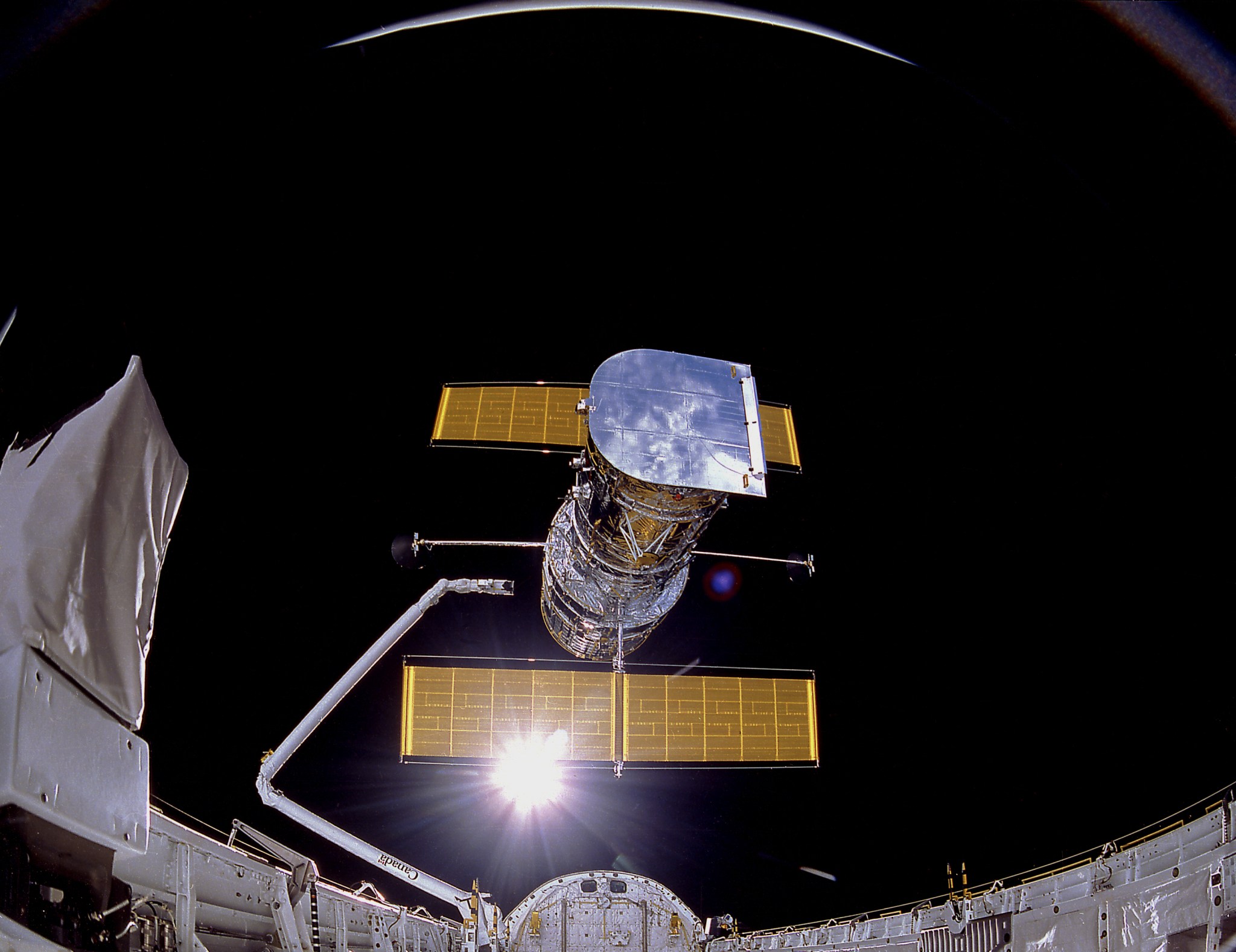
This week in 1990, the Hubble Space Telescope was deployed from the cargo bay of space shuttle Discovery as part of STS-31. NASA’s Marshall Space Flight Center was responsible for the design, development, and construction of the Hubble Space Telescope and has played a significant role in the testing of Hubble’s successor, the James Webb Space Telescope. Scheduled to launch in October 2018, the Webb telescope will observe the most distant objects in the universe, provide images of the first galaxies formed and see unexplored planets around distant stars. The NASA History Program is responsible for generating, disseminating, and preserving NASA’s remarkable history and providing a comprehensive understanding of the institutional, cultural, social, political, economic, technological, and scientific aspects of NASA’s activities in aeronautics and space. For more pictures like this one and to connect to NASA’s history, visit the Marshall History Program’s webpage. (NASA)
Obituaries
Cleo J. Peterson, 91, of Huntsville, died April 20. He retired from the Marshall Center in 1980 as an engineering technician. He is survived by his wife, Ruth Peterson.



























